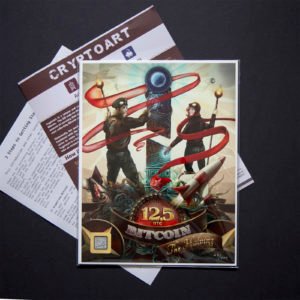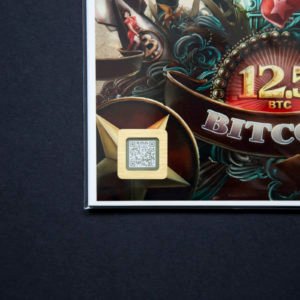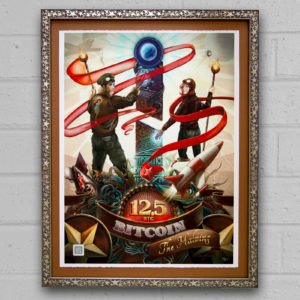I'm Troy Fearnow, founder of Cryptoart.com. I'm now on Steemit!
Ever since Tara blogged about us, I've been pretty excited about Steemit. It's wonderful to see creators truly rewarded for their efforts.
This post is a brief introduction to our product, a call for ideas about official Cryptoart for STEEM cryptocurrency, then finally an announcement for our newest Cryptoart piece, "The Halving II - Moon or Bomb."

At Cryptoart, we publish fine art paper wallets. These are highly elaborate illustrations that comment on the crypto culture and also serves as cold storage. It's a really fun visual way to enjoy your cryptocurrency. It also makes a great gift, because it is an easy medium to physically deliver Bitcoin or other currencies. You can find out specifics on how Cryptoart works here.
Call for STEEM Cryptoart ideas!
We currently have 14 Cryptoart editions published. This is over a two year time span since our launch. We're extremely picky about the images we publish. Knowing this, we invite the Steemit community to give us some subject matter ideas for creating the perfect STEEM Cryptoart. We try to introduce symbolism into each piece, so the more details the better. If we use your idea, we'll give you a free art piece! Like other Cryptoart editions, it will be a limited edition paper wallet for the STEEM cryptocurrency. Note: The private key can be swapped out without damaging the art piece.
New Release:




This is the sister edition to the “The Halving” created by artist Christina Hess in celebration of the Bitcoin Halvening. This piece represents the time period from the 2016 halving to the next halving in 2020 and pays tribute to BTC price speculation. Some suggest the reduction in Bitcoin inflation will create more scarcity and increase the price. Others suggest a reduction in block rewards will reduce miner participation and make the network less secure. The discussion seems ably illustrated as war-time propaganda.
The central element of this art piece is a rendition of the tally stick — an ancient device used to record debts between two parties. A stick was marked to signify the debt, then broken and given to each party. The larger half was given to the creditor and the short end given to the debtor. Similar to the private-key to public-key relationship of cryptography, only one pair could be combined to verify the debt. In this regard, tally sticks represent sound money by not contributing to fractional reserve banking.
I look forward to hearing your thoughts!
-Troy
